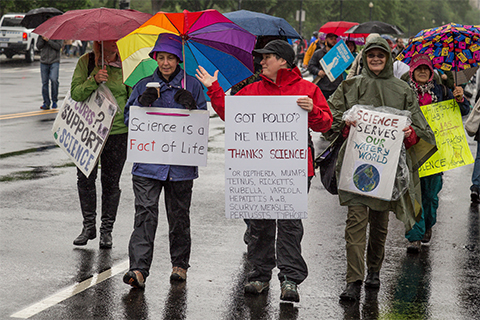Science activism is surging
Hundreds of scientists protested government efforts to restrict educational access to Western science theories, including Darwin’s theory of evolution, in June 2023 in India. Similarly, scientists in Mexico participated in a research strike in May 2023 to protest a national law they claimed would threaten the conditions for basic research. And during the same month in Norway, three scientists were arrested for protesting the nation’s slow-moving climate policy.

As these among many other actions show, scientists today are speaking out on a variety of political and social issues related to their own research fields and in solidarity with other social movements.
We are social scientists who study the relationship between science and society. Through our work, we’ve noticed more scientists seem empowered to advocate for a wide range of policy issues. We’re interested in how the surge in science activism may be changing the norms of scientific research.
With colleagues, we recently reviewed and summarized a growing body of studies examining how scientists are mobilizing for social activism and political protest. We also surveyed 2,208 members of the Union of Concerned Scientists Science Network to learn more about scientists’ political engagement. Here is what we have found so far.
A new wave of science activism
Science activism has long been considered taboo, as many in the field fear that politicizing science undermines its objectivity. Even so, scientist-activists have still managed to shape the U.S. political landscape throughout history. Over the past century, for example, scientists have protested the atomic bomb, pesticides, wars in Southeast Asia, genetic engineering and the federal response to the AIDS epidemic.
More recently, the election of Donald Trump in 2016 triggered a wave of political mobilization not seen in the United States since the Vietnam War era. In the context of the COVID-19 pandemic, climate change activism, Black Lives Matter and the #MeToo movement, scientists have also mobilized, and science advocacy organizations are playing important roles.
Some groups, like March for Science and Scientist Rebellion, are new and claim dozens of chapters and thousands of members around the world. In addition, older organizations like the Union of Concerned Scientists are growing, while once-defunct organizations like Science for the People have reemerged.
Science organizing also happens within universities, graduate student unions and professional associations. These groups use their connections to local communities and larger networks of science professionals to mobilize others in the scientific community.
Many science advocacy groups borrow protest tactics from previous eras, like mass marches and teach-ins. Others are more innovative, including “die-ins” at medical schools to protest police racial violence and data-rescue “hackathons” to protect public access to government data.
Some efforts mirror conventional forms of politics, like 314 Action, an organization that supports political candidates with STEM backgrounds. Others are more confrontational, such as Scientist Rebellion, some members of which blocked roads and bridges to demand action on the climate emergency.
Or, science advocacy can look indistinguishable from typical academic practices, like teaching. A new course taught by an MIT physics professor titled “Scientist Activism: Gender, Race and Power” helps raise student awareness about the political nature of science.
Professional norms may be shifting
We’ll need more research to determine how the resurgence of scientist activism is influencing politics and policy. But we can already point to some effects — the growth of science advocacy organizations, increased media attention to scientist activism, climate-friendly changes in investment policies at some universities, and more STEM-trained politicians. However, we also expect that impending crises, like climate change, may be driving acceptance of activism within the scientific community.
For example, when we asked scientists how often they should be politically active, 95% of our surveyed scientists answered “sometimes,” “most of the time,” or “always.” Our surveyed population is, by definition, politically engaged. But this near-uniform level of support for political action suggests that the professional norms that have long sanctioned scientist activism may be shifting.
Other findings from the survey strengthen this interpretation. Scientist activism often entails some level of personal or professional risk. But 75% of respondents told us their science-based advocacy had the support of their employers. Most surprisingly for us, respondents were twice as likely to report that activism helped to advance their careers — 22% — rather than damage them — 11%.
Our survey did find, however, that nonwhite scientists are more vulnerable to the risks of engaging in science advocacy. Seventeen percent of nonwhite scientists report negative career repercussions from their science advocacy, compared with less than 10% among white scientists. Yet compared with white respondents, nonwhite respondents are also more likely to engage in science advocacy.
While nonwhite respondents report higher rates of negative career impacts, the percentage reporting higher rates of career advancement from advocacy — 31% — was nearly double that for white respondents — 18%. This difference suggests that science advocacy has deeper career consequences — both good and bad — among nonwhite scientists. Although they are more likely to be rewarded for this activity, they are exposed to greater risk for doing so.
Emerging lessons
Two lessons emerge from our research thus far. First, our findings indicate that science activism may be gaining legitimacy within the scientific community. In this context, social media is helping mobilize and raise visibility among younger researchers. These researchers’ political experiences are informed by the climate justice, Black Lives Matter and #MeToo movements. As this newer generation of science activists moves into the profession, they will continue to shift the cultural norms of science.
Second, because race unevenly structures scientists’ experiences with activism, science activists can build on their current momentum by embracing intersectional solidarity. This means taking actions to center and engage marginalized groups within science. Intersectional solidarity can deepen activist engagement, enhance and diversify recruitment efforts, and increase its impact on social and ecological change.![]()
This article is republished from The Conversation under a Creative Commons license. Read the original article.
Enjoy reading ASBMB Today?
Become a member to receive the print edition four times a year and the digital edition monthly.
Learn moreGet the latest from ASBMB Today
Enter your email address, and we’ll send you a weekly email with recent articles, interviews and more.
Latest in Policy
Policy highlights or most popular articles

Embrace your neurodivergence and flourish in college
This guide offers practical advice on setting yourself up for success — learn how to leverage campus resources, work with professors and embrace your strengths.

ASBMB honors Lawrence Tabak with public service award
He will deliver prerecorded remarks at the 2025 ASBMB Annual Meeting in Chicago.

Summer internships in an unpredictable funding environment
With the National Institutes of Health and other institutions canceling summer programs, many students are left scrambling for alternatives. If your program has been canceled or delayed, consider applying for other opportunities or taking a course.

Black excellence in biotech: Shaping the future of an industry
This Black History Month, we highlight the impact of DEI initiatives, trailblazing scientists and industry leaders working to create a more inclusive and scientific community. Discover how you can be part of the movement.

ASBMB releases statement on sustaining U.S. scientific leadership
The society encourages the executive and legislative branches of the U.S. government to continue their support of the nation’s leadership in science.

ASBMB and advocacy: What we accomplished in 2024
PAAC members met with policymakers to advocate for basic scientific research, connected some fellow members with funding opportunities and trained others to advocate for science.


